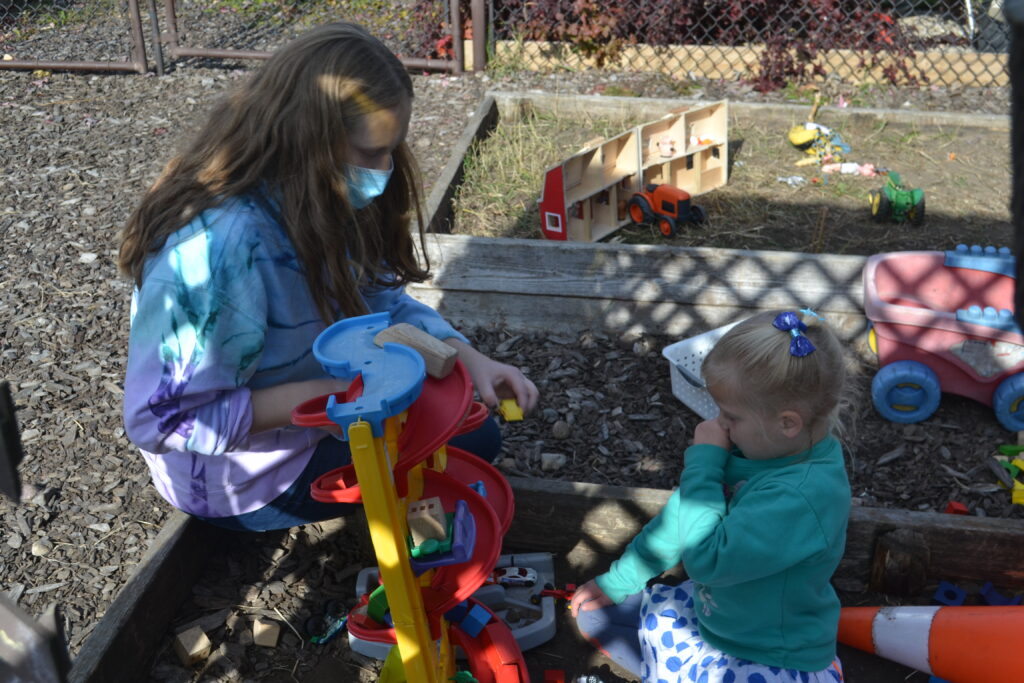Child Care Providers, Parents Call for More Funding
Advocate says system ‘will collapse’ without state aid when pandemic relief ends.

A child care worker engages a child at The Growing Tree child care center in New Glarus. Photo by Erik Gunn/Wisconsin Examiner.
The year 2023 has just begun, but Wisconsin operators of licensed child care programs and the parents who depend on child care so they can go to work are looking ahead nervously to 2024.
Since early in the COVID-19 pandemic, the nation’s child care systems have been teetering as providers work to keep children safe, contain outbreaks when they occur and recruit a dwindling number of job applicants. In Wisconsin, some centers have scaled back their official capacity because they can’t hire and keep enough employees.
The Growing Tree child care center in New Glarus receives about $4,000 a month. That has made it possible for the center to give raises to its employees and to avoid hiking tuition, according to Brooke Skidmore, the center’s operator. “Right now that money is keeping our doors open,” she says.
But the Wisconsin Department of Children and Families (DCF) program that has been making those monthly stabilization grants is scheduled to end in 2024. The program, Child Care Counts, was funded through Wisconsin’s share of the federal American Rescue Plan Act.
If that money isn’t replaced, more than 60% of Wisconsin child care operators in a national survey said they would have to raise tuition or cut pay in order to keep operating — neither of which is a sustainable option, says Ruth Schmidt, executive director of the Wisconsin Early Childhood Association (WECA).
The association is campaigning for $300 million to be included in the state’s 2023-25 budget to pick up those stabilization grants starting in 2024 through the end of the biennium in June 2025. That wouldn’t be just a one-time expense, however: Schmidt says it would need to be the start of an ongoing commitment.
“It’s a looming disaster if we don’t get this money,” says Corrine Hendrickson, a child care provider and advocate for the profession.
Exposing child care’s challenges
WECA is leading Raising Wisconsin, a campaign to mobilize child care providers, parents and employers, who have begun to understand the role that child care is playing as a barrier to some potential workers.
The COVID-19 pandemic turned a spotlight on the struggles the child care industry had been facing for years before the pandemic began — and it made those struggles worse. “Child care was an issue pre-COVID,” says Schmidt. “COVID accelerated the pace” at which the problem grew.
Subsequent iterations of Child Care Counts included incentive pay for child care workers to return, followed by aid to help centers that had closed reopen so parents could return to their workplaces. The monthly stabilization payment program followed, starting in late 2021.
In the nearly three years since the pandemic started, the state has put $824 million in federal pandemic relief into child care, according to DCF communications director Gina Paige, including more than $600 million into the various Child Care Counts programs.
“Wisconsin was seen as a leader in expediting the system by which they could pump money from the federal government out into the bank accounts of child care programs to keep them open,” says Schmidt. And the state also made it a priority to direct some of that money to increase the pay for child care workers, she adds.
Wages have been chronically low in child care. “Even after you’ve worked in child care for a long time — five, six, seven, eight years — you’re still making entry level type wages that you see in other industries,” Schmidt says. “And I think that’s a real problem.”
Wages rise, but shortages persist
Child care operators say using the aid to support their workforce has been critical.
In Dodge County, Tricia Peterson operates Future All Stars Academy with a capacity for 48 children. When the current round of Child Care Counts money first arrived in 2021, “I gave everybody bonuses every month,” Peterson says. “Last year, in 2022, I took the plunge and gave everybody a raise.”
She says that has brought average wages from $10-$15 an hour to $13-$17, and she can’t see trying to cut employees’ pay if the stabilization payments end a year from now.
Even with the state’s help through the stabilization money, child care shortages are widespread.
Angela Jones, a professor at the University of Wisconsin-Eau Claire, had planned to enroll her youngest daughter in child care about a year ago, three months after she was born. But the center where her older daughter was already enrolled was short on staff due to a COVID surge, and with an infant too young still to get the vaccine, the family decided to delay her child care until the fall of 2022.
“She was supposed to start the day after Labor Day,” says Jones. Two weeks earlier, however, some staff resigned unexpectedly, and the center closed its infant enrollment. Jones spent the fall semester juggling help from neighbors, part-time sitters and working from home.
Now past her first birthday, Jones’ younger daughter began child care at another center out of town this week. “We’re hoping that it’s sustainable,” she says. “But like all the other centers, they’re struggling to find and keep staff.”
Jones, whose academic work focuses on education and disability, has done research on those subjects as they relate to child care.
“Child care in general in the United States is a peculiar market,” she says. “It is not sustainable on its own. Families can only afford to pay so much for care, and we know that providers are not able to pay a living wage solely on what the market pays.”
The Child Care Counts stabilization money helped fill the gap. “Without that revenue stream coming in to help providers increase their wage to a livable wage, the child care system will collapse,” Jones says.
Waiting lists, capacity cutbacks
Staff shortages are already taking a toll.
The Growing Tree used to have a licensed capacity of 100 children before the COVID-19 pandemic, says Skidmore. “With COVID I lost half my staff, [because] they didn’t want to work in an environment where they would be very susceptible” to being exposed to the virus.
Unable to hire enough staff to meet the facility’s original capacity, she voluntarily reduced her license to a capacity of 60 children. There are currently 54 enrolled.
At Future All Stars Academy, Peterson has a waiting list of 50 children, most of them for infants. Her policy is that families with a child already enrolled and who are expecting go to the top of the waiting list.
While the number of licensed operators in Wisconsin is now slightly more than in March 2020, just before the pandemic took hold, there is still a widespread critical shortage of child care. Paige of DCF says the number of providers has fallen in the northern and western parts of the state while they are increasing in the southeast.
On paper, the current statewide capacity in December 2022 was about 250 licensed child care slots fewer than in December 2019, before the pandemic. But the true occupancy might be less.
Eau Claire resident Claire Lindstrom says her family “got kind of lucky with our child care” — but at a price. She and her husband have a 2-year-old son in care, and the family also needs some before- and after-school care for her 6-year-old daughter as well as care in the summer.
Her provider’s rates have been climbing. “They’re just trying to keep their doors open and pay their bills,” says Lindstrom. “I don’t fault them for that.”
Still the current cost — more than $10,000 a year, and another $3,000 or more when summer and part-time care for her older child is included — makes contemplating yet another increase if the stabilization money the center receives disappears “hard to imagine,” she says.
“We probably would just have to look at our family’s budget and start cutting a lot of things that we rely on and pinching pennies to make the day-to-day work.”
Schmidt of the Wisconsin Early Childhood Association says she’s confident that when Gov. Tony Evers presents his proposed budget next month, it will include child care provisions.
In the 2021-23 budget, the Republican leaders of the Legislature’s Joint Finance Committee declined to provide funding at the level Evers had proposed then for child care, citing the availability of the pandemic relief funds as a resource.
But they did approve the administration’s ARPA-funded Child Care Counts plan, Schmidt observes. She’s hopeful that with that money exhausted, they will now be willing to make up the difference.
“I think there’s a deeper understanding from both sides of the political aisle as to the depth of this issue, and the impact that it’s having,” Schmidt says.
Child care providers, parents campaign for new budget infusion was originally published by the Wisconsin Examiner.


















